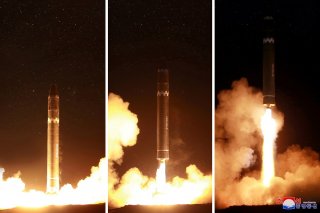South Korea, U.S. Following Movements at North Korean Missile Sites
The militaries of the United States and South Korea are closely monitoring movements at North Korea’s missile facilities but have yet to see any signs that might be cause for alarm.
The militaries of the United States and South Korea are closely monitoring movements at North Korea’s missile facilities but have yet to see any signs that might be cause for alarm.
“There is no unusual movement detected as of now,” South Korea’s deputy Defense Ministry spokesperson Col. Moon Hong-sik said on Thursday during a regular press briefing.
“Our military is closely following North Korea’s missile activities, and the South Korea-U.S. intelligence authorities are maintaining a close cooperation system,” he added.
Earlier in the day, North Korean First Vice Foreign Minister Choe Son-hui said that Pyongyang will continue to ignore any direct contact from the United States unless the Joe Biden administration ends its continuous “hostile” policies.
He also vowed to deal with the United States “on the principle of answering force with toughness and good faith in kind.”
Last month, the Defense Ministry confirmed that the reclusive state had been expanding its missile development facilities, but it wasn’t able to see any unusual activities at its demolished Punggye-ri nuclear testing site or the long-suspended nuclear reactor at Yongbyon complex.
Earlier in the week, Air Force Gen. Glen VanHerck, commander of the U.S. Northern Command and North American Aerospace Defense Command, said that Pyongyang may be striving to resume its long-range missile testing to better gauge the capability of a new intercontinental ballistic missile (ICBM) that was unveiled at a military parade last October.
The isolated East Asian nation conducted its sixth and final nuclear test in late 2017 and has since maintained a self-imposed moratorium on nuclear and long-range missile testing. VanHerck, however, noted that North Korea has already declared that it is “no longer bound” by such restrictions.
“The North Korean regime has also indicated that it is no longer bound by the unilateral nuclear and ICBM testing moratorium announced in 2018, suggesting that Kim Jong-un may begin flight testing an improved ICBM design in the near future,” the four-star general said in a statement submitted to the Senate Armed Services Committee.
“Despite U.S. efforts in 2020 to reach an agreement with Kim Jong-un, North Korea continued its development of ICBMs capable of striking targets in the United States. As North Korea continues its pursuit of advanced long-range strategic weapons including the new systems displayed during their 10 October 2020 parade—USNORTHCOM remains committed to maximizing the capability and capacity of our ballistic missile defense systems.”
Adm. Phil Davidson, the commander of U.S. Indo-Pacific Command, also shared similar sentiments. Last week, the four-star admiral declared that the United States and its allies in the Pacific should be on guard as North Korea poses a “serious” and “immediate” threat, adding that the country over the years has continued to develop its nuclear and delivery systems that are designed to strike the United States.
Ethen Kim Lieser is a Minneapolis-based Science and Tech Editor who has held posts at Google, The Korea Herald, Lincoln Journal Star, AsianWeek, and Arirang TV. Follow or contact him on LinkedIn.

